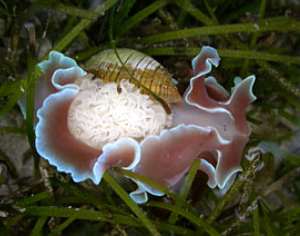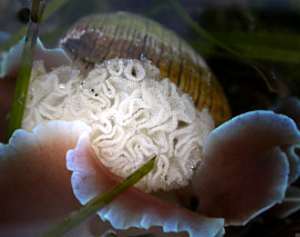|
LIFE HISTORY & BEHAVIOUR
Feeding
Head Shieldslugs have well-developed sensory structures to detect prey such as other opisthobranchs.
H. physis has well-developed sensory mechanisms which it uses to feed on polychaete worms of the family Cirratulidae(Debelius 1998). The animal burrows just below the sand surface with the aid of a wedge-shaped head shield.
The bubble shell gives the general impression that all species have shells, though this is not always the case. Some epifaunal species have very strong shells, which they can retract into while others may be infernal and have very thin shells, or none at all. Most have no rhinophores on the head, which has an expanded head shell used for burrowing beneath the substrate in search of prey. Most are carnivores feeding on a range of smaller invertebrates including polychaete worms, molluscs and forms. Some are thought to nibble sponges andothers eat filamentous algae. They all emit copious amounts of slime (Figure 17), a few can swim and a number are nocturnal (Coleman 2001).
Reproduction
Opisthobranchs are hermaphrodites, maintaining active male and female sex organs with reproductive pores positioned on the right side of their necks (Coleman 2001). When two members of the same species recognize each other using chemoreception, contact is made using the body, and a certain amount of ‘courting’ commences.These displays vary, and can be characterized by crawling around each other in circles lining up their genital openings. They can mate with any mature individual of the same species and in some cases form communal mating groups and mating chains. Copulation may continue for several hours to days.
Reciprocal receipt of sperm is through everted genital organs and a stylet-like penis is designed for deep penetration. Each individual produces its own egg mass, and in H. physis, the egg mass of this species is attached to the sand by a mucous thread (Debelius 1998). In many cases, egg ribbons are laid on, or near a food source and the shape, size, colour and situation are characteristic of each specific group (Coleman 2001). Before the eggs are laid, the egg mass is gathered on the mantle (Figure 8) before being released onto the sand.
  Figure 7. Hydatina physis mating in a group (Poddubetskaia, M., 2005).
Figure 7. Hydatina physis mating in a group (Poddubetskaia, M., 2005).
  Figure 8. Hydatina physis laying eggs. (Hutton, I., 2004)
Figure 8. Hydatina physis laying eggs. (Hutton, I., 2004)
Development
In opisthobranchs, development from egg-laying to hatching takes an average of 11 days (Hadfield and Switzer Dunlap 1984). The short period in H. physis (5 days) may be partly due to the warm water in which the embryos and/or larvae develop. However, growth and mortality rates in H. physis may vary depending on the conditions an individual is in (Hamel & Marcier 2007).
Most forms of opisthobranks haveplanktotrophic larvae (Behrens 2005). The majority of development occurs whenmany small eggs with shelled veligers are distributed by the currents, followedby metamorphosis when they land at a location that is suitable for theirdevelopment. The minority develop directly with fewer and larger eggs thatemerge as crawling juveniles. However, different species’ employ varyingmethods of development.
Movement
Opisthobranchs can perform four main types of locomotion: crawling, swimming, tailing and burrowing. Of these four, H. physis has been observed to use two forms: crawling and burrowing.
Crawling
Opisthobranchs crawl on a flat, flexible "foot" located beneath the body. At a young age, many species of opisthobranchs conduct their movement by ciliary action (similar to Platyhelminthes) running along the base of the foot. In H. physis, the transverse waves move backwards in reverse to the direction that the slug is moving (Coleman 2001).
The foot is composed of two muscular bands: a thick encircling outer band that remains in contact with the substrate the majority of the time and an elongate inner strip of tissue, known as the sole. The sole makes contact with the substrate only when waves of muscular contractions, moving from front to rear, pull the animal forward. In some families, these muscular waves run completely across the inner band, while in other families the band is divided down the middle and the muscular waves alternate between the left and right sides.
Movement of H. physis ➵ http://vimeo.com/42065835
Burrowing
H. physis uses burrowing as an important strategy to search for food. Burrowing can also be used to hide from predators or to anchor their bodies into the soft sediment during periods of strong current. Like H. physis, some opisthobranchs that use this method are able to bury themselves and to use the exposed body parts to maintain their location during tidal exchanges and periods of fast currents, and monitor changes in water conditions and respiration before again resurfacing completely.
 Figure 9. A Hydatina physis burrowing in search of prey (Coleman 2001).
Figure 9. A Hydatina physis burrowing in search of prey (Coleman 2001).
Respiration
Oxygen is extracted by opisthobranch gills from seawater in H. physis. When threatened, the external gills are able to quickly retract inside protective pockets (Coleman 2001). |